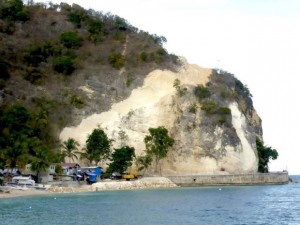DENR 7: Remove excavated rocks atop Ili Rock before the typhoon comes
Piles of excavated limestone on top of Ili Rock in Boljoon town, south Cebu must be removed immediately before typhoon Ruby reaches the Visayas today.
This is to avoid the risk of rocks falling on passing motorists and residents, said Isabelo Montejo, regional executive director of the Dept. of Environment and Natural Resources (DENR) 7.
The order was given during a technical conference on Thursday called by the DENR to discuss violations in ongoing work by the Department of Public Works and Highways (DPWH).
Montejo noted several possible violations in the project.
Several trees were cut without a permit from the DENR, and the reclamation project, which is being undertaken using excavated rocks and debris from Ili Rock, lacked public consultation and legal authority, he said.
He said the DPWH and Boljoon town can’t implement a reclamation project on its own under the law and that an 8,000-square meter reclamation is not necessary to protect coastal residents from typhoons.
The dumping of limestone debris in the sea may also involve a violation of the Water Code of the Philippines because of the negative impact on marine life, he noted.
Since October, earth-moving work by the DPWH has been done to terrace part of the limestone cliff of Ili Rock to reduce the risk of landslides and rock falls in a procedure called ‘slope benching’.
Residents, alarmed by the defaced heritage site, complained about the damage to the town’s landmark mountain, and lack of public consultation.
In November, fishermen protested when boulders and debris were dumped on the shoreline of the Poblacion for the beginning of a reclamation project.
The DENR’s immediate concern is the excavated rocks on the mountain.
“It should be removed as soon as possible. My directive is for DPWH to ask the contractor not to pull out the equipment until they get permission from the governor. But they have to minimize excavation and focus on stabilizing the slope,” said Montejo during the meeting at the DENR office in Cebu City.
At the meeting, land claimant Teofilo Silagan, a retired colonel, said his property in Ili Rock was excavated without his permission. He asked DENR to act on the illegal cutting of trees.
Boljoon Mayor Merlou Derama said the reclamation project was a form of protection for coastal residents from strong waves when a typhoon occurs.
He said the Cebu Archdiocese agreed to donate a two-hectare upland lot as a relocation site but this didn’t materialize because residents living by the shore didn’t want to move.
Municipal administrator Ruben Niere told the DENR that since coastal residents didn’t want to relocate, they agreed to have a reclamation project made instead for their protection.
Both the “slope benching” and reclamation projects, covered by two contracts worth P98 million, were suspended by the DPWH 4th engineering district following a Nov. 21 public forum in Boljoon, where residents complained about the damage to Ili Rock and disturbance to the livelihood of fishermen.
Montejo said a reclamation project was not needed to protect coastal fisherfolk.
“If there is political will, these residents can be relocated to a safer ground and this area (where the houses used to stand) has a big potential as a tourist destination where buses can park and tourists can enjoy the scenery. This way Boljoon can generate more income,” Montejo told officials.
He observed that no controversy would have erupted in Boljoon if DPWH officials had conducted a public consultation with stakeholders.
The DPWH was earlier issued a Certificate of Non-Coverage (CNC) for the slope protection work undertaken by contractor QM Builders which exempts it from the requirement of an Environmental Compliance Certificate (ECC).
Montejo told DPWH District Engineer Delloso of the 4th Engineering District that the DPWH can’t undertake a reclamation on its own.
Only the Philippine Reclamation Authority (PRA) and local governments with new charters can undertake a reclamation. He advised Boljoon Mayor Derama to talk to Gov. Hilario Davide III for the province to consider taking over the project.
But the mayor has to convince the Boljoon municipal council to withdraw its Nov. 17 resolution opposing the project.
A total of 86 trees were cut during the excavation work in Ili Rock, said Flordeliza Geyrozaga, OIC of CENRO Argao. She identified them as 53 Ipil-ipil, 2 Bolbolanon, 20 Sala, 4 Tigpod and 7 Malaiba trees. Many other trees were cutk she said, but they could no longer be identified as the stumps were covered with debris.
Engr. Marlon Marollano, chief planning officer and project engineer of DPWH 4th Engineering District said these were not trees but “shrubs” considering their size.
Montejo corrected him: “Regardless of their size, these are still trees.”
The penalty still has to be assessed depending on the nature of the trees.
He reminded them that Public Works Secretary Rogelio Singson issued a policy that no DPWH projects should proceed if it involves cutting and removal of trees unless the trees are damaged.
The Boljoon project started after the directive was issued.
Montejo said political issues may have also muddle the issue and suggested that Boljoon officials come up with a united stand on both projects.
At least 68 fisherfolk signed a protest petition that moved the Bojoon municipal council to appeal to the DPWH to suspend the excavation.
To counter that, Engr. James Dellosa, district engineer, read a letter from a Boljoanon backed by 70 signatures asking DPWH to continue the project for their protection.
“Lessons have been learned. We hope that there will be a win-win solution to all these,” Montejo said.


